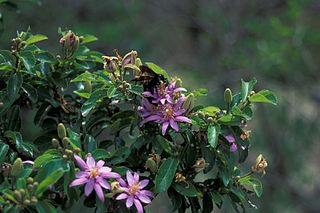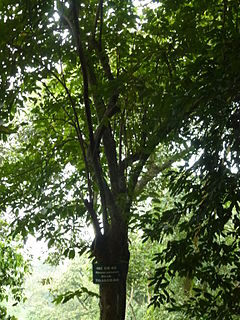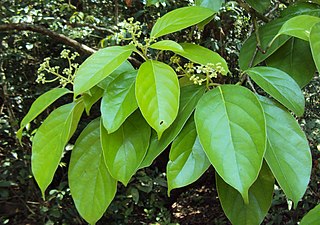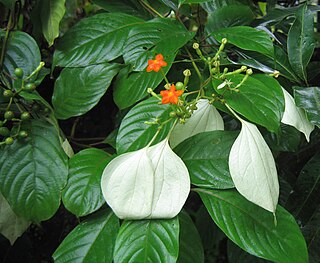
Mangifera is a genus of flowering plants in the cashew family, Anacardiaceae. It contains approximately 69 species, with the best-known being the Common Mango. The center of diversity is in subtropical and tropical South Asia and Southeast Asia, while the highest number of species occur in India. They are generally canopy trees in lowland rainforests, reaching a height of 30–40 m (98–131 ft).
Tiliaceae is a botanical name for a family of flowering plants. It is not a part of the APG, APG II and APG III classifications, being sunk in Malvaceae as a modified Tilioideae but has an extensive historical record of use.

Litsea is a genus of evergreen or deciduous trees or shrubs belonging to the laurel family, Lauraceae. The genus includes a large number of accepted species in tropical and subtropical areas of North America and Asia.

Mesua is a genus of flowering plants in the family Calophyllaceae, native to tropical southern Asia. Common names include ironwood and rose chestnut.

The large flowering plant genus Grewia is today placed by most authors in the mallow family Malvaceae, in the expanded sense as proposed by the Angiosperm Phylogeny Group. Formerly, Grewia was placed in either the family Tiliaceae or the Sparrmanniaceae. However, these were both not monophyletic with respect to other Malvales - as already indicated by the uncertainties surrounding placement of Grewia and similar genera - and have thus been merged into the Malvaceae. Together with the bulk of the former Sparrmanniaceae, Grewia is in the subfamily Grewioideae and therein the tribe Grewieae, of which it is the type genus.

Archidendron is a genus of flowering plants in the pea family, Fabaceae.

Microcos is a genus of flowering plants in the family Malvaceae sensu lato or Tiliaceae or Sparrmanniaceae.

Antirhea is a genus of flowering plants in the family Rubiaceae.

Mastixia is a genus of about 19 species of resinous evergreen trees, usually placed in the family Cornaceae. Its range extends from India through Southeast Asia and New Guinea to the Solomon Islands. Mastixia species have alternate or opposite simple broad leaves, many-flowered inflorescences, and blue to purple drupaceous fruits.

Neonauclea is a genus of flowering plants in the family Rubiaceae. It comprises about 71 species. Neonauclea is a genus of shrubs and trees They are indigenous to China, India, Southeast Asia, Wallacea, New Guinea and Australia.

Colona is a genus of flowering plant in the Malvaceae sensu lato or Tiliaceae: now placed in the subfamily Grewioideae. It is found in south-east Asia.

Mussaenda is a genus of flowering plants in the family Rubiaceae. They are native to the African and Asian tropics and subtropics. Several species are cultivated as ornamental plants.

Gynochthodes is a genus of flowering plants in the family Rubiaceae. The genus is found from Madagascar to tropical and subtropical Asia and the Pacific region.

Trichospermum galeottii is a species of flowering plant in the family Malvaceae. It was first described by Russian botanist Nikolai Turczaninow and it was given its current name by André Joseph Guillaume Henri Kostermans in 1962. Its native range spans the area between Mexico and Northwestern Venezuela and Peru.












